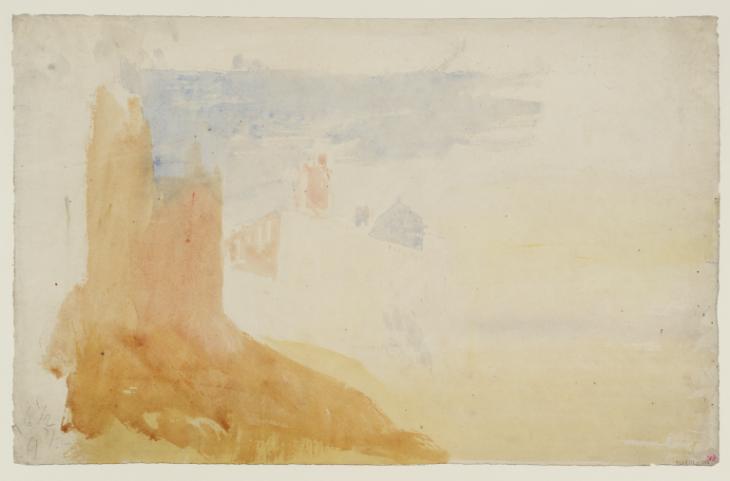Joseph Mallord William Turner Linlithgow Palace and St Michael's Church c.1821
Joseph Mallord William Turner,
Linlithgow Palace and St Michael's Church
c.1821
Joseph Mallord William Turner 1775–1851
Linlithgow Palace and St Michael’s Church c.1821
D25325
Turner Bequest CCLXIII 203
Turner Bequest CCLXIII 203
Watercolour on white wove paper, 247 x 388 mm
Inscribed by Turner in pencil ‘6 ½ | 9 ½’ bottom left
Blind-stamped with Turner Bequest monogram bottom centre
Inscribed in red ink ‘203’ bottom right
Stamped in black ‘CCLXIII – 203’ bottom right
Inscribed by Turner in pencil ‘6 ½ | 9 ½’ bottom left
Blind-stamped with Turner Bequest monogram bottom centre
Inscribed in red ink ‘203’ bottom right
Stamped in black ‘CCLXIII – 203’ bottom right
Accepted by the nation as part of the Turner Bequest 1856
Exhibition history
1999
Turner and Sir Walter Scott: The Provincial Antiquities and Picturesque Scenery of Scotland, National Gallery of Scotland, Edinburgh, December 1999–March 2000 (29, as ‘Colour Study of Linlithgow Palace’, c.1821, reproduced in colour).
References
1820
A.J. Finberg, A Complete Inventory of the Drawings of the Turner Bequest, London 1909, vol.II, p.830, CCLXIII 203, as ‘The red towers’, c.1820–30.
1997
Eric Shanes, Turner’s Watercolour Explorations 1810–1842, exhibition catalogue, Tate Gallery, London 1997, pp.28, 101 Appendix I ‘Scotland’.
1821
Katrina Thomson, Turner and Sir Walter Scott: The Provincial Antiquities and Picturesque Scenery of Scotland, exhibition catalogue, National Gallery of Scotland, Edinburgh 1999, pp.31, 88 no.29, as ‘Colour Study of Linlithgow Palace’, c.1821, pl.14 (colour).
Eric Shanes noted Ian Warrell’s unpublished identification of this slight but fairly precise colour study as showing Linlithgow Palace, based largely on a pencil drawing in the 1818 Scotch Antiquities sketchbook (Tate D13660–D13661; Turner Bequest CLXVII 43a–44).1 As Thomas Ardill describes in his entries for the sketch, it shows the ruined palace from the south-east, with St Michael’s Parish Church in the foreground, only represented by a detail of one buttress, as the church had been recorded separately from a similar angle (Tate D13656–D13657; Turner Bequest CLXVII 41a–42).
The articulation of the castle’s façade, otherwise reserved as blank white paper, is limited to the cast shadows of the corbelling below the roofline. The angle of the bright sunlight against the east side of the castle and the various south-facing elements in shadow (experimentally alternating between warm brown and cool blue) would indicate an early morning in summer. Given the relatively dark bulk of the church, Turner perhaps intended to represent it in repoussoir shadow, cast by cloud or the trees which crowd in from the right in the original drawing.
In the event, as he established a working design to be engraved for Walter Scott’s Provincial Antiquities of Scotland (see the Introduction to this section), in September 1821 Turner abandoned this scheme for a completely different one showing the castle in the distance at evening, as discussed in the entry for another colour study (Tate D25316; Turner Bequest CCLXIII 194). He may have decided that a low-angled view, although impressive, would be too similar to that adopted for Roslyn Castle (Indianapolis Museum of Art), possibly already completed,2 and engraved in 1823 (Tate impressions: T04493, T06062). Turner did not return to Linlithgow, but his recollection of this potential composition may have influenced his choice of viewpoint (albeit from another direction) in the vignette watercolour Linlithgow of about 1833 (Victoria and Albert Museum, London),3 engraved for Scott’s Prose Works in 1836 (Tate impression: T04755).
Andrew Wilton, J.M.W. Turner: His Life and Work, Fribourg 1979, p.426 no.1065, as c.1823, reproduced, on the basis of a supposed watermark of that year; but see Martin F. Krause, Turner in Indianapolis: The Pantzer Collection of Drawings and Watercolors by J.M.W. Turner and his Contemporaries at the Indianapolis Museum of Art, Indianapolis 1997, p.137 no.39, as c.1820, reproduced in colour, with the watermark given as 1819.
Verso:
Blank; inscribed by ?John Ruskin in pencil ‘AB 150 P | O’ bottom right; inscribed in pencil ‘CCLXIII | 203’ bottom right.
Matthew Imms
July 2016
How to cite
Matthew Imms, ‘Linlithgow Palace and St Michael’s Church c.1821 by Joseph Mallord William Turner’, catalogue entry, July 2016, in David Blayney Brown (ed.), J.M.W. Turner: Sketchbooks, Drawings and Watercolours, Tate Research Publication, February 2017, https://www

